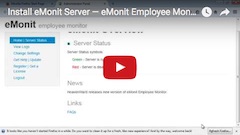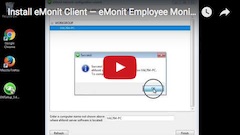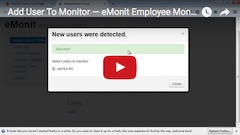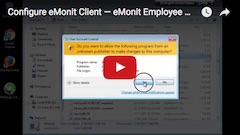eMonit FAQs
Go to a category:
- A. General information about eMonit
- B. Installing and Uninstalling eMonit
- C. Getting and registering eMonit licenses
- D. Opening and closing the Admin Panel
- E. Viewing eMonit logs
- F. Changing eMonit settings
- G. Getting help and using other resources
- H. Videos on YouTube
1. Can I try eMonit before I buy it?
Yes. You can get an eMonit trial license by visiting eMonit's home page, clicking Download, and providing HeavenWard your contact information. The trial license is free, fully functional, and allows you to monitor up to five computers for 10 days. You can find additional information about eMonit trial versions in Chapter 2 of the eMonit Installation Guide, "Selecting a License Option."
2. How many computers can eMonit monitor?
You can monitor any number of computers with eMonit. eMonit is designed, however, for small and mid-size companies and for monitoring approximately 5 to 20 computers.
3. Do employees know they are being monitored by eMonit?
You can choose whether or not employees are notified that they are being monitored by configuring the program to present or not present an eMonit icon in the system tray of monitored users. For instructions, see FAQ 1, "How do I change eMonit monitoring options?" in section F, "Changing eMonit settings," below.
4. What are the system requirements for installing eMonit?
System requirements for installing eMonit are modest. eMonit must be installed on Windows operating systems, and all computers must be in the same network workgroup. For details about system requirements, see Chapter 1 of the eMonit Installation Guide, "Checking System and Network Requirements."
5. Are eMonit log files secured through encryption?
Yes. eMonit logs are encrypted as they are recorded and stored temporarily on each monitored computer. The encrypted logs are transmitted approximately every 60 seconds to the supervisor’s computer (where eMonit server software is installed). Once transmitted, they are deleted from the monitored computer.
Yes. You can get an eMonit trial license by visiting eMonit's home page, clicking Download, and providing HeavenWard your contact information. The trial license is free, fully functional, and allows you to monitor up to five computers for 10 days. You can find additional information about eMonit trial versions in Chapter 2 of the eMonit Installation Guide, "Selecting a License Option."
2. How many computers can eMonit monitor?
You can monitor any number of computers with eMonit. eMonit is designed, however, for small and mid-size companies and for monitoring approximately 5 to 20 computers.
3. Do employees know they are being monitored by eMonit?
You can choose whether or not employees are notified that they are being monitored by configuring the program to present or not present an eMonit icon in the system tray of monitored users. For instructions, see FAQ 1, "How do I change eMonit monitoring options?" in section F, "Changing eMonit settings," below.
4. What are the system requirements for installing eMonit?
System requirements for installing eMonit are modest. eMonit must be installed on Windows operating systems, and all computers must be in the same network workgroup. For details about system requirements, see Chapter 1 of the eMonit Installation Guide, "Checking System and Network Requirements."
5. Are eMonit log files secured through encryption?
Yes. eMonit logs are encrypted as they are recorded and stored temporarily on each monitored computer. The encrypted logs are transmitted approximately every 60 seconds to the supervisor’s computer (where eMonit server software is installed). Once transmitted, they are deleted from the monitored computer.
1. How do I install eMonit?
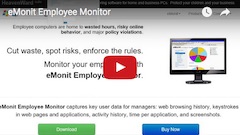
To install eMonit, you download and run the eMonit installation file on each monitored computer and on the supervisor's computer where log files are viewed. Installation does not require any special technical knowledge. Follow the installation steps in the eMonit Installation Guide. To read the PDF Guide, you'll need the free Adobe Reader or other PDF reader.
2. How do I use the eMonit network configuration wizard?
The network configuration wizard opens automatically during installation of eMonit software on monitored computers. After a few moments, the wizard displays the names of computers in your Microsoft Windows network. From those names, you select the supervisor’s computer, where you installed the eMonit software used for viewing computer logs. When you click Finish, the wizard checks that computer to make sure the correct software is installed on it. If the wizard cannot find the correct software on the computer you selected, it provides options for continuing. Note that the network configuration wizard is included in eMonit beginning with version 2.10. For additional information, see the chapter called Installing Client Components in the eMonit Installation Guide. To read the PDF Guide, you’ll need the free Adobe Reader or other PDF reader.
3. How do I uninstall eMonit?
To uninstall eMonit, make sure all computers on which eMonit client software is installed are running. Then go to the supervisor’s computer (where eMonit server software is installed) and click start, then Programs, then HeavenWard, then eMonit, and then Uninstall. All server and client software is uninstalled and all log files are deleted.

To install eMonit, you download and run the eMonit installation file on each monitored computer and on the supervisor's computer where log files are viewed. Installation does not require any special technical knowledge. Follow the installation steps in the eMonit Installation Guide. To read the PDF Guide, you'll need the free Adobe Reader or other PDF reader.
2. How do I use the eMonit network configuration wizard?
The network configuration wizard opens automatically during installation of eMonit software on monitored computers. After a few moments, the wizard displays the names of computers in your Microsoft Windows network. From those names, you select the supervisor’s computer, where you installed the eMonit software used for viewing computer logs. When you click Finish, the wizard checks that computer to make sure the correct software is installed on it. If the wizard cannot find the correct software on the computer you selected, it provides options for continuing. Note that the network configuration wizard is included in eMonit beginning with version 2.10. For additional information, see the chapter called Installing Client Components in the eMonit Installation Guide. To read the PDF Guide, you’ll need the free Adobe Reader or other PDF reader.
3. How do I uninstall eMonit?
To uninstall eMonit, make sure all computers on which eMonit client software is installed are running. Then go to the supervisor’s computer (where eMonit server software is installed) and click start, then Programs, then HeavenWard, then eMonit, and then Uninstall. All server and client software is uninstalled and all log files are deleted.
1. What kinds of licenses are available for eMonit?
Both free trial and paid licenses are available. Paid licenses are active for one year. To purchase a paid license, visit eMonit's order page. eMonit trial licenses are free, fully functional, and allow you to monitor up to five computers for 10 days. You can get a trial license by clicking Download at eMonit's home page and providing HeavenWard your contact information. You can find additional information about eMonit trial versions in Chapter 2 of the eMonit Installation Guide, "Selecting a License Option."
2. How do I add monitored computers after reaching the maximum allowed by my current license?
To add monitored computers after reaching the maximum allowed by your license, you must purchase another license for the number of additional computers you want to monitor. To purchase another license, visit eMonit's order page. Then register your license. See FAQ 3, "How do I register (activate) a license key?," below in this section.
3. How do I register (activate) a license key?
To register a license key and activate your software, open the eMonit Admin Panel and click Register | Get a License. Open the Register license tab and enter your user name, email address, and license key. Then click Register. An internet connection is required.
Both free trial and paid licenses are available. Paid licenses are active for one year. To purchase a paid license, visit eMonit's order page. eMonit trial licenses are free, fully functional, and allow you to monitor up to five computers for 10 days. You can get a trial license by clicking Download at eMonit's home page and providing HeavenWard your contact information. You can find additional information about eMonit trial versions in Chapter 2 of the eMonit Installation Guide, "Selecting a License Option."
2. How do I add monitored computers after reaching the maximum allowed by my current license?
To add monitored computers after reaching the maximum allowed by your license, you must purchase another license for the number of additional computers you want to monitor. To purchase another license, visit eMonit's order page. Then register your license. See FAQ 3, "How do I register (activate) a license key?," below in this section.
3. How do I register (activate) a license key?
To register a license key and activate your software, open the eMonit Admin Panel and click Register | Get a License. Open the Register license tab and enter your user name, email address, and license key. Then click Register. An internet connection is required.
1. How do I open eMonit's Admin Panel?
The Admin Panel is where log files form monitored computers are viewed. To open the Admin Panel, you must be on the computer where eMonit server software is installed (called the "supervisor's computer") or be able to access it remotely. On the supervisor's computer, click start, then Programs, then HeavenWard, then eMonit, and then AdminPanel. The Password Action window opens in your default web browser. Enter your password and then click Login. The Admin Panel opens.
2. How do I log out of the Admin Panel?
To log out of the Admin Panel, click Logout in the Admin Panel main menu. The Password Action window opens, which you can now close.
The Admin Panel is where log files form monitored computers are viewed. To open the Admin Panel, you must be on the computer where eMonit server software is installed (called the "supervisor's computer") or be able to access it remotely. On the supervisor's computer, click start, then Programs, then HeavenWard, then eMonit, and then AdminPanel. The Password Action window opens in your default web browser. Enter your password and then click Login. The Admin Panel opens.
2. How do I log out of the Admin Panel?
To log out of the Admin Panel, click Logout in the Admin Panel main menu. The Password Action window opens, which you can now close.
1. How do I get an overview of eMonit logs?
To see an overview of eMonit logs for a monitored computer, open the Admin Panel (see Section D, "Opening and closing the Admin Panel," above), and click View Logs in the main menu. The names of computers eMonit is monitoring are displayed. Click a computer name. The User Overview window opens showing three pie-chart overviews of activity on the selected computer: Time totals summary (cumulative time each application ran) Web browsing summary (time on each web page) and Programs run summary (which programs ran). Links to logs for specific activities monitored on the computer are also displayed in the main menu below the computer name. Click any activity to access details.
2. How do I view a chronological history of activity on a computer?
To view the history of activity on a monitored computer in chronological order, open the Admin Panel. Click View Logs and the name of the computer. Then click Activity History. The Activity History window opens. Start time shows the time at which each program window opened. Time shows the amount of time it was open. You can customize the logs shown by clicking Filter to select a time period, a program, or both.
3. How do I view the total time a program was used on a computer?
To view the total time a program window was open on a monitored computer, open the Admin Panel. Click View Logs and the name of the computer. Then click Time Totals. The Time Totals window opens. You can customize the logs shown by clicking Filter to select a time period, a program, or both.
4. How do I view keystroke logs?
To view keystrokes made in most applications and web browsers on a monitored computer, open the Admin Panel. Click View Logs and the name of the computer. Then click Keystrokes. The Keystrokes window opens. You can customize the logs shown by clicking Filter to enter text to search for, a time period, a program, or any combination of these.
5. How do I view screenshots?
To view screenshots made on a monitored computer, open the Admin Panel. Click View Logs and the name of the computer. Then click Screenshots. The Screenshots window opens. Click on any image to enlarge it. To view screenshots for specific time period, click Filter and enter a date range.
6. How to I view web browsing history?
To view web browsing history on a monitored computer, open the Admin Panel. Click View Logs and the name of the computer. Then click Web Browsing. The Web Browsing window opens. You can customize the logs shown by clicking Filter to select a browser, a date range, or both.
7. How do I view the programs run on a computer?
To view the programs run on a monitored computer, open the Admin Panel. Click View Logs and the name of the computer. Then click Programs Run. The Programs Run window opens. A list of programs run is shown. Count is the number of times each program was started since new log files were begun. You can customize the logs shown by clicking Filter to select a program.
To see an overview of eMonit logs for a monitored computer, open the Admin Panel (see Section D, "Opening and closing the Admin Panel," above), and click View Logs in the main menu. The names of computers eMonit is monitoring are displayed. Click a computer name. The User Overview window opens showing three pie-chart overviews of activity on the selected computer: Time totals summary (cumulative time each application ran) Web browsing summary (time on each web page) and Programs run summary (which programs ran). Links to logs for specific activities monitored on the computer are also displayed in the main menu below the computer name. Click any activity to access details.
2. How do I view a chronological history of activity on a computer?
To view the history of activity on a monitored computer in chronological order, open the Admin Panel. Click View Logs and the name of the computer. Then click Activity History. The Activity History window opens. Start time shows the time at which each program window opened. Time shows the amount of time it was open. You can customize the logs shown by clicking Filter to select a time period, a program, or both.
3. How do I view the total time a program was used on a computer?
To view the total time a program window was open on a monitored computer, open the Admin Panel. Click View Logs and the name of the computer. Then click Time Totals. The Time Totals window opens. You can customize the logs shown by clicking Filter to select a time period, a program, or both.
4. How do I view keystroke logs?
To view keystrokes made in most applications and web browsers on a monitored computer, open the Admin Panel. Click View Logs and the name of the computer. Then click Keystrokes. The Keystrokes window opens. You can customize the logs shown by clicking Filter to enter text to search for, a time period, a program, or any combination of these.
5. How do I view screenshots?
To view screenshots made on a monitored computer, open the Admin Panel. Click View Logs and the name of the computer. Then click Screenshots. The Screenshots window opens. Click on any image to enlarge it. To view screenshots for specific time period, click Filter and enter a date range.
6. How to I view web browsing history?
To view web browsing history on a monitored computer, open the Admin Panel. Click View Logs and the name of the computer. Then click Web Browsing. The Web Browsing window opens. You can customize the logs shown by clicking Filter to select a browser, a date range, or both.
7. How do I view the programs run on a computer?
To view the programs run on a monitored computer, open the Admin Panel. Click View Logs and the name of the computer. Then click Programs Run. The Programs Run window opens. A list of programs run is shown. Count is the number of times each program was started since new log files were begun. You can customize the logs shown by clicking Filter to select a program.
1. How do I change eMonit monitoring options?
To change eMonit monitoring options (the activities eMonit monitors), click Change Settings in the Admin Panel main menu. Then click Monitoring Options. The Monitoring Options window opens. Select the activities you want to monitor. You can also select Put eMonit icon in system tray of monitored users to alert users that they are being monitored. Note: the monitoring options you select here apply to all computers eMonit monitors.
2. How do I view a list of the computers eMonit is monitoring?
To view the computer names of the computers eMonit is monitoring, click Change Settings in the Admin Panel main menu. Then click User Computers. The User Computers window opens. The Computers now monitored section lists the computers eMonit is monitoring. The Newly found computers section shows names of computers on which eMonit client software was recently installed but which are not being monitored. To stop receiving notification of these computers, select a computer and click Ignore. The Computers not being monitored section shows names of computers on which eMonit client software is installed but which are not being monitored and are not being announced as newly found computers. To remove these computers from all notifications and lists, select a computer and click Remove.
3. How do I delete eMonit log files?
To delete the files eMonit has generated while monitoring a computer, click Change Settings in the Admin Panel main menu. Then click Delete Logs. The Delete Computer Logs window opens. Select a computer and click Delete. Note: when you click Delete, all log files for the selected computers are deleted and cannot be restored.
4. How do I configure error reporting?
To set eMonit to send error logs automatically to the HeavenWard server, click Change Settings in the Admin Panel main menu. Then click Error Reporting. The Error Reporting window opens. Select Automatically send error reports to HeavenWard's server to enable error reporting. Then click Apply. An internet connection is required.
5. How do I change the Admin Panel password?
To change the Admin Panel password, click Change Settings in the Admin Panel main menu. Then click Admin Password. The Admin Password window opens. Enter your old password, new password, and new password confirmation. Then click Apply.
To change eMonit monitoring options (the activities eMonit monitors), click Change Settings in the Admin Panel main menu. Then click Monitoring Options. The Monitoring Options window opens. Select the activities you want to monitor. You can also select Put eMonit icon in system tray of monitored users to alert users that they are being monitored. Note: the monitoring options you select here apply to all computers eMonit monitors.
2. How do I view a list of the computers eMonit is monitoring?
To view the computer names of the computers eMonit is monitoring, click Change Settings in the Admin Panel main menu. Then click User Computers. The User Computers window opens. The Computers now monitored section lists the computers eMonit is monitoring. The Newly found computers section shows names of computers on which eMonit client software was recently installed but which are not being monitored. To stop receiving notification of these computers, select a computer and click Ignore. The Computers not being monitored section shows names of computers on which eMonit client software is installed but which are not being monitored and are not being announced as newly found computers. To remove these computers from all notifications and lists, select a computer and click Remove.
3. How do I delete eMonit log files?
To delete the files eMonit has generated while monitoring a computer, click Change Settings in the Admin Panel main menu. Then click Delete Logs. The Delete Computer Logs window opens. Select a computer and click Delete. Note: when you click Delete, all log files for the selected computers are deleted and cannot be restored.
4. How do I configure error reporting?
To set eMonit to send error logs automatically to the HeavenWard server, click Change Settings in the Admin Panel main menu. Then click Error Reporting. The Error Reporting window opens. Select Automatically send error reports to HeavenWard's server to enable error reporting. Then click Apply. An internet connection is required.
5. How do I change the Admin Panel password?
To change the Admin Panel password, click Change Settings in the Admin Panel main menu. Then click Admin Password. The Admin Password window opens. Enter your old password, new password, and new password confirmation. Then click Apply.
1. How do I check for available software updates?
To check for updates to eMonit software, click Get Help in the Admin Panel main menu. Then click About. The About eMonit Employee Monitor window opens. Click Check for Update. The message Your current version is up to date indicates no update is available. If the message A new version is available is displayed, a link for downloading the update will be shown in the Server section following Download Link:. A description of the update is also provided. An internet connection is required. For instructions on installing updates, see FAQ 2, "How do I update eMonit software?," below in this section.
2. How do I update eMonit software?
If you check for eMonit software updates (see FAQ 1, "How do I check for available software updates?," above in this section) and find that an update is available, then you can install the update by following the steps in Chapter 9 of the eMonit Installation Guide, "Installing eMonit Software Updates."
3. How can I access eMonit FAQs?
You can find the internet link to eMonit FAQs by clicking Get Help in the Admin Panel main menu. Then click Read eMonit FAQs. The Read eMonit FAQs window opens. Click the FAQs link to open the FAQs in your default browser. An internet connection is required.
4. How do I contact eMonit Support?
To send a support request to HeavenWard from within the Admin Panel, click Get Help in the main menu. Then click Email Support. The Email eMonit Support window opens. Complete the fields in the window, entering your question in the Text field. Then click Send. An internet connection is required. A reply to your request will be sent to the email address you provided. You can also email Support at support@hwsuite.com.
5. How can I send feature requests or other comments about eMonit to HeavenWard?
To send feature requests, comments, or testimonials about eMonit to HeavenWard from within the Admin Panel, click Get Help in the main menu. Then click Request a Feature to open the Request a New eMonit Feature window. To send other comments, click Write a Testimonial to open the Write a Testimonial window. Complete all fields, entering your message in the Text field. Then click Send. An internet connection is required.
To check for updates to eMonit software, click Get Help in the Admin Panel main menu. Then click About. The About eMonit Employee Monitor window opens. Click Check for Update. The message Your current version is up to date indicates no update is available. If the message A new version is available is displayed, a link for downloading the update will be shown in the Server section following Download Link:. A description of the update is also provided. An internet connection is required. For instructions on installing updates, see FAQ 2, "How do I update eMonit software?," below in this section.
2. How do I update eMonit software?
If you check for eMonit software updates (see FAQ 1, "How do I check for available software updates?," above in this section) and find that an update is available, then you can install the update by following the steps in Chapter 9 of the eMonit Installation Guide, "Installing eMonit Software Updates."
3. How can I access eMonit FAQs?
You can find the internet link to eMonit FAQs by clicking Get Help in the Admin Panel main menu. Then click Read eMonit FAQs. The Read eMonit FAQs window opens. Click the FAQs link to open the FAQs in your default browser. An internet connection is required.
4. How do I contact eMonit Support?
To send a support request to HeavenWard from within the Admin Panel, click Get Help in the main menu. Then click Email Support. The Email eMonit Support window opens. Complete the fields in the window, entering your question in the Text field. Then click Send. An internet connection is required. A reply to your request will be sent to the email address you provided. You can also email Support at support@hwsuite.com.
5. How can I send feature requests or other comments about eMonit to HeavenWard?
To send feature requests, comments, or testimonials about eMonit to HeavenWard from within the Admin Panel, click Get Help in the main menu. Then click Request a Feature to open the Request a New eMonit Feature window. To send other comments, click Write a Testimonial to open the Write a Testimonial window. Complete all fields, entering your message in the Text field. Then click Send. An internet connection is required.
